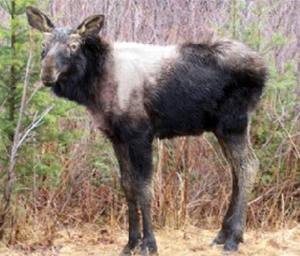Moose In A Changing Climate
How our Changing Climate is Impacting New Hampshire’s Moose

Climate change is currently affecting moose through weather conditions which result in higher parasitism of moose by winter ticks and brainworm. These parasites decrease moose survival and suppress adult cow reproduction.
Moose experience heat-related stress when there is a combination of high solar radiation, ambient temperature, or humidity. Due to their large body size, it takes time for heat to build and dissipate inside a moose, so sequential days of these conditions have a greater influence.
Moose minimize the influence of high temperatures and humidity by resting in areas of shade with air circulation or cool water, which also provides relief from insects. Habitats with these features, thermal refugia, include mature conifer forest, primarily balsam fir and spruce, and forested wetlands.
Higher temperatures and more severe droughts predicted with climate change will affect moose long-term by: 1) increasing the frequency of hot and humid weather that is stressful for moose; and 2) reducing the availability of areas where moose find thermal refugia through decline of balsam fir and spruce forests and surface water availability.
What Can Residents Do to Help Moose?
- Support local and regional land conservation groups. Work within your town to conserve open space.
- Climate change leads to winter ticks and brainworm, threatening moose in New Hampshire. Become informed on climate change and take steps to reduce your carbon footprint.
- Support balanced forest management that creates a mix of young forests and conifer cover.
- Young Forests Initiative



